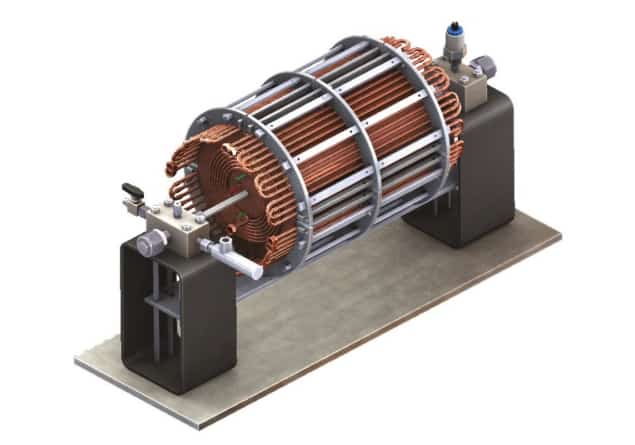
Scientists at Google and several research institutes in North America have reopened what they call the “cold case” of cold fusion. The researchers argue that those dismissing work on cold fusion – for which there is no reproducible experimental evidence – may have been “premature” in their assessment of its worth. The team has also carried out experiments of its own, which did not provide any evidence for cold fusion. Despite the many failures to observe cold fusion, the scientists maintain that the case is not yet closed. They also argue that cold-fusion research benefits other areas of science and technology.
Cold fusion hit the headlines 30 years ago in 1989, when chemists Martin Fleischmann of the University of Southampton in the UK and Stanley Pons of the University of Utah in the US announced at a press conference in Utah that they had observed nuclear fusion in a remarkably simple experiment. When passing electricity through samples of heavy water (deuterium oxide) containing palladium electrodes, they reported the net production of energy as well as the detection of neutrons and tritium. The reactions responsible, they claimed, must have been nuclear rather than chemical. This meant that some unknown mechanism had caused the deuterium nuclei in the electrodes to overcome their mutual electrostatic repulsion and get close enough to fuse.
Hailed by some at the time as a virtually inexhaustible source of clean nuclear energy, cold fusion also generated huge controversy. Many physicists insisted that fusion could not occur to any measurable degree at room temperature. Then and now, conventional fusion experiments rely on very powerful magnets or lasers to heat nuclei to millions of degrees to overcome their mutual repulsion. The biggest fusion reactor today, known as ITER, is being built in the south of France to the tune of €20bn.
Technical failures
Now, a study funded by the US-based technology giant Google has re-investigated the original cold-fusion result as well as some of those from the small number of groups that have continued to study the hypothetical phenomenon. Many scientists consider such research a waste of time, pointing to the many failed attempts at reproducing cold-fusion observations. But Matthew Trevithick and colleagues at Google reckoned that those failures might have been due to technical problems rather than the impossibility of cold fusion. “There were very few data available to assess whether cold fusion is correct or not,” says Trevithick, who takes a special interest in alternative energy sources.
In 2015, Trevithick approached Curtis Berlinguette, a chemist at the University of British Columbia in Canada, and then put together a roughly 30-strong research team using $10m of funding from Google – a small fraction of the company’s (undeclared) total research budget. The team has managed to keep its work under wraps until now – to the extent that even some of Berlinguette’s own research group were not aware of it. Now, the team leaders describe their results in a “Perspective” article in Nature.
Among its objectives, the team wanted to find out just how much deuterium they could pack into an electrode. Normally palladium absorbs about 0.7 hydrogen atoms for each atom in the metal lattice. According to a long-standing claim, however, fusion could kick-in if this reaches 0.875. Although the researchers exceeded this threshold just twice over the course of several dozen tests, Berlinguette says they now better understand how to boost absorption and limit leaks. “Our data confirm that hydrogen likes to enter palladium nanoparticles at vertices and not faces,” he explains. “That gives us some clues about how to design materials to get to higher sustained hydrogen concentrations”.
Potential pitfalls
The team also spent a lot of time trying to understand the potential pitfalls involved in measuring heat fluxes under extreme conditions. For many years, researchers in Italy have claimed that certain metallic powders yield excess energy when heated within hydrogen gas. So Berlinguette and colleagues modelled, built and tested several calorimeters (see figure) to try and pin down all the different ways that heat could flow into and out of a cold fusion experiment. Testing 420 samples of nickel powder, they found that none “provided evidence of excess heat”.

Ignition pending
The team also looked at work done in the mid-1990s at the Los Alamos National Laboratory in New Mexico. The Los Alamos team did low-energy table top experiments that used a pulsed plasma discharge to drive deuterons into a palladium cathode. They reported detecting tritium, which is a by-product of fusion. In research described in the Nature article, Thomas Schenkel and colleagues at the Lawrence Berkeley National Laboratory in California carried-out similar experiments for weeks at a time but saw no enhanced production of tritium.
Overall, the researchers conclude that they “have found no evidence of anomalous effects claimed by proponents of cold fusion that cannot otherwise be explained prosaically”. Nevertheless, they maintain that their research “leaves open the possibility” that cold fusion is real. Indeed, Trevithick says that realizing what is known as a “reference experiment” – providing evidence of cold fusion that is unambiguous and independently verifiable – “is our goal and remains our goal”.
Plus, he adds, the research could prove useful in other areas. One example is the analysis of how hydrogen is absorbed by palladium – something, he and his colleagues write, which is relevant to energy storage, catalysis and sensing.



